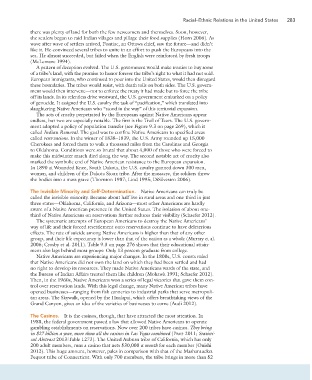Page 310 - Essencials of Sociology
P. 310
Racial–Ethnic Relations in the United States 283
there was plenty of land for both the few newcomers and themselves. Soon, however,
the settlers began to raid Indian villages and pillage their food supplies (Horn 2006). As
wave after wave of settlers arrived, Pontiac, an Ottawa chief, saw the future—and didn’t
like it. He convinced several tribes to unite in an effort to push the Europeans into the
sea. He almost succeeded, but failed when the English were reinforced by fresh troops
(McLemore 1994).
A pattern of deception evolved. The U.S. government would make treaties to buy some
of a tribe’s land, with the promise to honor forever the tribe’s right to what it had not sold.
European immigrants, who continued to pour into the United States, would then disregard
these boundaries. The tribes would resist, with death tolls on both sides. The U.S. govern-
ment would then intervene—not to enforce the treaty it had made but to force the tribe
off its lands. In its relentless drive westward, the U.S. government embarked on a policy
of genocide. It assigned the U.S. cavalry the task of “pacification,” which translated into
slaughtering Native Americans who “stood in the way” of this territorial expansion.
The acts of cruelty perpetrated by the Europeans against Native Americans appear
endless, but two are especially notable. The first is the Trail of Tears. The U.S. govern-
ment adopted a policy of population transfer (see Figure 9.3 on page 269), which it
called Indian Removal. The goal was to confine Native Americans to specified areas
called reservations. In the winter of 1838–1839, the U.S. Army rounded up 15,000
Cherokees and forced them to walk a thousand miles from the Carolinas and Georgia
to Oklahoma. Conditions were so brutal that about 4,000 of those who were forced to
make this midwinter march died along the way. The second notable act of cruelty also
marked the symbolic end of Native American resistance to the European expansion.
In 1890 at Wounded Knee, South Dakota, the U.S. cavalry gunned down 300 men,
women, and children of the Dakota Sioux tribe. After the massacre, the soldiers threw
the bodies into a mass grave (Thornton 1987; Lind 1995; DiSilvestro 2006).
The Invisible Minority and Self-Determination. Native Americans can truly be
called the invisible minority. Because about half live in rural areas and one-third in just
three states—Oklahoma, California, and Arizona—most other Americans are hardly
aware of a Native American presence in the United States. The isolation of about one-
third of Native Americans on reservations further reduces their visibility (Schaefer 2012).
The systematic attempts of European Americans to destroy the Native Americans’
way of life and their forced resettlement onto reservations continue to have deleterious
effects. The rate of suicide among Native Americans is higher than that of any other
group, and their life expectancy is lower than that of the nation as a whole (Murray et al.
2006; Crosby et al. 2011). Table 9.3 on page 276 shows that their educational attain-
ment also lags behind most groups: Only 13 percent graduate from college.
Native Americans are experiencing major changes. In the 1800s, U.S. courts ruled
that Native Americans did not own the land on which they had been settled and had
no right to develop its resources. They made Native Americans wards of the state, and
the Bureau of Indian Affairs treated them like children (Mohawk 1991; Schaefer 2012).
Then, in the 1960s, Native Americans won a series of legal victories that gave them con-
trol over reservation lands. With this legal change, many Native American tribes have
opened businesses—ranging from fish canneries to industrial parks that serve metropoli-
tan areas. The Skywalk, opened by the Hualapai, which offers breathtaking views of the
Grand Canyon, gives an idea of the varieties of businesses to come (Audi 2012).
The Casinos. It is the casinos, though, that have attracted the most attention. In
1988, the federal government passed a law that allowed Native Americans to operate
gambling establishments on reservations. Now over 200 tribes have casinos. They bring
in $27 billion a year, more than all the casinos in Las Vegas combined (Pratt 2011; Statisti-
cal Abstract 2013:Table 1273). The United Auburn tribe of California, which has only
200 adult members, runs a casino that nets $30,000 a month for each member (Onishi
2012). This huge amount, however, pales in comparison with that of the Mashantucket
Pequot tribe of Connecticut. With only 700 members, the tribe brings in more than $2

